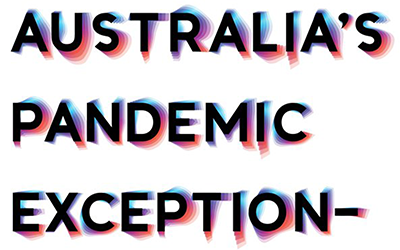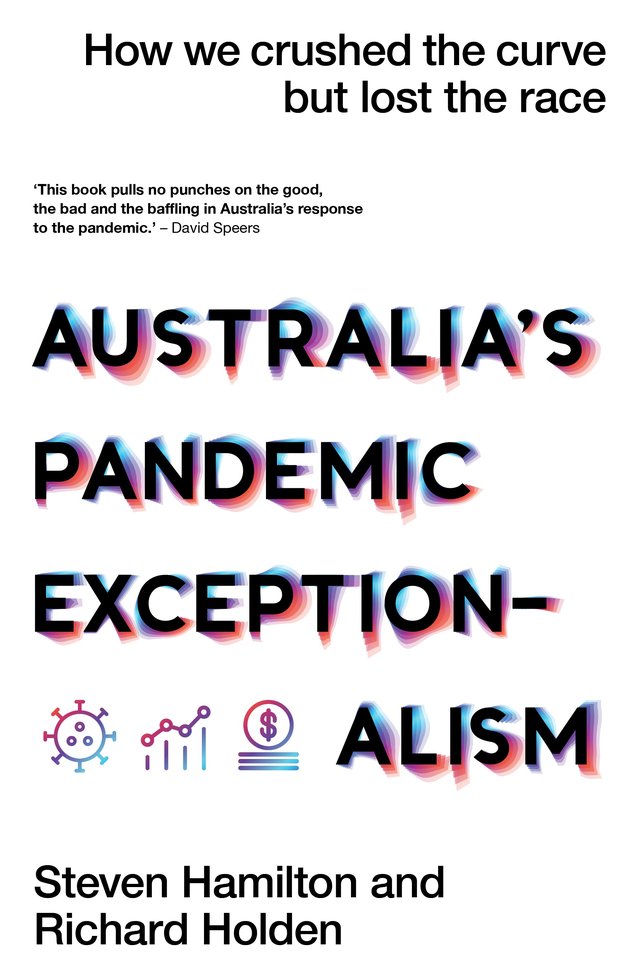
- Free Article: No
- Contents Category: Pandemic
- Review Article: Yes
- Article Title: ‘We right to go?’
- Article Subtitle: Heeding the lessons of the Covid-19 pandemic
- Online Only: No
- Custom Highlight Text:
The Covid-19 pandemic has left its mark on all of us. How could it not? The shuttered small businesses; the warring states; the spectre of aged care residents, hands pressed against glass, unable to touch or receive relatives. The Centrelink queues, the taped-up playgrounds, the closed borders. The stranded cruise ships, the panic buying of toilet paper, the unrelenting and crushing boredom of our four walls. Personally, I can’t see a North Face jacket without a visceral flashback to our erstwhile Victorian premier and his trademark press conference opener: ‘We right to go?’ The desire to forget all of this, to move on from the pandemic, is what makes Australia’s Pandemic Exceptionalism: How we crushed the curve but lost the race such an important contribution to the literature of Covid-19 post-mortems.
- Featured Image (400px * 250px):

- Alt Tag (Featured Image): Johanna Leggatt reviews ‘Australia’s Pandemic Exceptionalism: How we crushed the curve but lost the race’ by Steven Hamilton and Richard Holden
- Book 1 Title: Australia’s Pandemic Exceptionalism
- Book 1 Subtitle: How we crushed the curve but lost the race
- Book 1 Biblio: UNSW Press, $39.99 pb, 234 pp
- Book 1 Cover Small (400 x 600):

- Book 1 Cover (800 x 1200):

From the outset, the authors challenge the dominant political shibboleth that there is no point poring over the entrails of what occurred or what might have been – becoming what Scott Morrison has called ‘hindsight heroes’. They argue, saliently, that there is good reason to study our mistakes so that we can learn from them. They also demolish the false equivalence of the ‘Let It Rip Fringe’, which advocated an end to lockdowns in order to boost the economy and save businesses. As the authors note ‘we knew it was magical thinking to suppose that quickly loosening the restrictions on movement that had been put in place would actually be beneficial for economic reasons’.
Australia’s early response to the health crisis – ramping up ICU hospital capacity, closing the international border, and limiting movement – helped crush the curve and keep our death total among the lowest per capita in the world, alongside other developed nations, such as New Zealand and South Korea. The early fiscal response, which consisted of three economic packages announced over eighteen days, was all the more impressive for the fact that the surplus-obsessed Liberal Party was behind the largesse. Hamilton and Holden argue that the cornerstone of the fiscal response, the JobKeeper payment, was adroitly designed and delivered. Crucially, it kept Australians connected to their employers, which in turn discouraged mass sackings during the long lockdowns and allowed for an easy ramp-up of business when restrictions finally lifted. But the true ‘unsung hero’ of the fiscal response was the Australian Tax Office’s Single Touch Payroll framework, which wasn’t built for JobKeeper, but turned out to be stunningly effective in delivering it. The scheme wasn’t perfect – many commentators have claimed that the ‘turnover test’ was flawed, and others have argued for claw-back provisions for overpaid businesses – but, as the authors note, if JobKeeper ‘encouraged an otherwise-profitable firm to retain a worker it otherwise wouldn’t retain, then it’s reasonable to view it as a success’.
Nonetheless, this astonishing achievement was followed by dilly-dallying and short-termism in vaccine procurement. Morrison famously claimed vaccine orders were ‘not a race’, but the authors disagree. ‘The sooner we got vaccines, the sooner these restrictions could be lifted,’ they note. The problem, as they saw it, was that our leaders put all our eggs into two vaccine baskets – the proposed UQ vaccine that was abandoned and the less-effective AstraZeneca – while failing to place sufficient orders for a variety of potential success stories. The Australian government thereby violated a basic tenet of economic policy when outcomes are unknown: diversification. Indeed, in mid-2021, while other nations were securing their vaccines, news reports surfaced of leaked emails showing that Pfizer representatives requested a formal meeting with then-health minister Greg Hunt to discuss supply contracts, but were directed to a department bureaucrat ten days later. Hamilton and Holden claim that it is ‘simply undeniable’ that the federal government was driven by a fantasy of domestic manufacturing, of Australian jabs in Australian arms. As the authors put it: ‘The UQ and AstraZeneca vaccines could be produced in Victoria, and so that’s what we ordered.’
 Daniel Andrews, 2020 (Michael Currie/Alamy)
Daniel Andrews, 2020 (Michael Currie/Alamy)
Australia compounded this failure by a sclerotic medical-regulatory complex that was slow to approve the use of RATs, to permit easy self-isolating. The Therapeutic Goods Administration (TGA) approved RATs for home use one year later than the Food and Drug Administration (FDA) in America. Furthermore, the government RATs were inferior tests, which, ironically, is what made them so effective: they were less likely to pick up a ‘dead virus’ than the so-called gold-standard PCR tests, which were so effective as to be counterproductive. RATs chiefly detect a live virus – the kind we need to worry about. In failing to order and distribute enough RATs, Australia’s medical chiefs and leaders deprived the nation of their immense convenience and drove us into lengthy testing queues for PCR tests that could take days to produce results. In doing so, ‘they confused statistical accuracy with economic usefulness’.
The authors are less astute, less thorough, when examining why these serious failures took place. In the book’s Foreword, the American-born Hamilton notes the occasional difficulty he faced in gaining traction among the journalists who help shape national debate and influence policy. Hamilton laments the fact that Australians seem to ‘love credentialism’ and that in this country ‘time served is taken far more seriously than the merits of an argument’. The result? ‘The policy discussion in Australia is fundamentally undemocratic, and the country is the poorer for it,’ Hamilton writes. It would have been more persuasive had he returned to this idea to tease out how this national fealty to post-nominals impacted the policy response. Lacking, too, is a thorough exploration of how Australia’s federation affected the response of governments and the experience of its citizens. New Zealand, we are told, did remarkably well in containing the virus – with fewer deaths per capita than Australia – but New Zealand has a national constitution, not a federation of states, and Australians’ experience of the pandemic was determined by which state you happened to live in at the time. This proclivity for states to act unliterally surely warrants further in-depth discussion, particularly considering that the independent twelve-month inquiry into the Covid-19 response, which was due to report by 30 September, will exclude consideration of decision-making by states and territories. Earlier this year, a Senate inquiry into our Covid-19 response recommended a royal commission with investigative powers. Disappointingly, government members disagreed, pointing to the existence of the independent inquiry.
Hamilton and Holden have written a well-argued account of the policy strengths and weaknesses of our pandemic response, one that, in the absence of a royal commission, is sorely needed. As the authors put it: ‘There will be another pandemic. It might not happen for another century, or it might happen very soon.’ The risk is that in the rush to resume our normal lives – unmolested by curfews, five-kilometre travel limits, and invasive PCR swabs – we fail to learn the lessons of the past.


Comments powered by CComment